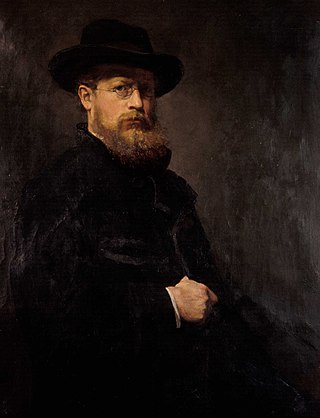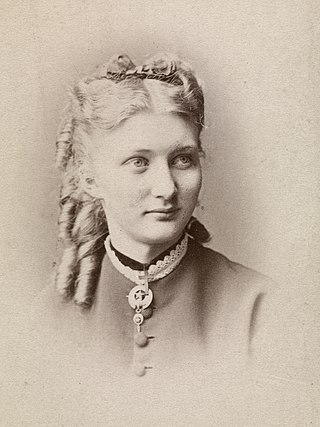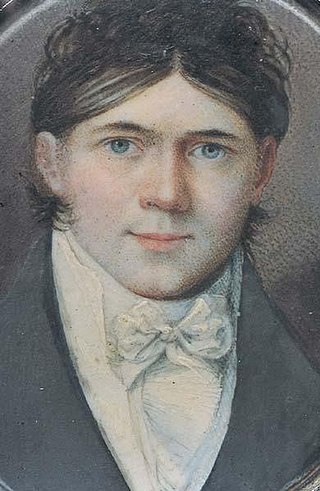
Johan Christian Claussen Dahl, often known as J. C. Dahl or I. C. Dahl, was a Danish-Norwegian artist who is considered the first great romantic painter in Norway, the founder of the "golden age" of Norwegian painting. He is often described as "the father of Norwegian landscape painting" and is regarded as the first Norwegian painter to reach a level of artistic accomplishment comparable to that attained by the greatest European artists of his day. He was also the first to acquire genuine fame and cultural renown abroad. As one critic has put it, "J.C. Dahl occupies a central position in Norwegian artistic life of the first half of the 19th century.

Christian Skredsvig was a Norwegian painter and writer. He employed an artistic style reflecting naturalism. He is especially well known for his picturesque and lyrical depictions of the landscape.

Adolph Tidemand was a noted Norwegian romantic nationalism painter. Among his best known paintings are Haugianerne and Brudeferd i Hardanger, painted in collaboration with Hans Gude.
Olaf Helliesen Lange was a Norwegian painter and print maker. Lange's fin-de-siècle art has its own special approach visualizing the complexity of the modern urban life.

Nils Severin Lynge Hansteen was a Norwegian painter. He was known principally for his landscape painting as well as his marine art, often featuring ships in a stormy seas.

Hjalmar Eilif Emanuel Peterssen was a Norwegian painter. He is most commonly associated with his landscapes and portraits. He gained early recognition for the history painting Christian II signing the Death Warrant of Torben Oxe and established himself as one of Norway's foremost portrait painters, with portraits of, among others, Henrik Ibsen and Edvard Grieg. He also became known for his landscape paintings, and became part of the artist circle known as the Skagen Painters. He also became known for his design in 1905 of Norway's national coat of arms with the Norwegian lion, which was used by the government and the royal house. The design is still used in the royal coat of arms and the royal flag.

Knud Geelmuyden Bull was a Norwegian painter and counterfeiter. He studied as a painter, was convicted for printing false bank notes, and was deported from the United Kingdom to Australia during 1846. He lived in Australia the remainder of his life, becoming a significant artistic painter there.

Marcus Frederik Steen Grønvold was a Norwegian painter. He painted genre scenes, historical and religious motifs and portraits as well as landscapes.

Anders Castus Svarstad was a Norwegian painter, most frequently associated with his urban landscapes.

Grete Ingeborg Johanne Andrea Gram was a Norwegian painter. She is best known for her landscapes and portraits.

Johan Fredrik Eckersberg was a Norwegian painter most noted for his landscapes. Eckersberg was a prominent figure in the transition from Romanticism to Realism in 19th-century Norwegian art, both as an artistic painter and a teacher at his own art school in Oslo.

Ludvig Karsten was a Norwegian painter. He was a neo-impressionist influenced by Edvard Munch, Henri Matisse and contemporary French painting. He first participated at the Autumn exhibition in Kristiania in 1901, and had his first separate exhibition in 1904. He is represented at museums in many Scandinavian cities, including several paintings at the National Gallery of Norway. Karsten was known for his bohemian lifestyle and quick temper.

Thomas Fearnley was a Norwegian romantic painter, a pupil of Johan Christian Dahl and a leading representative of Norwegian romantic nationalism in painting. His son Thomas Fearnley (1841–1927) founded the Fearnley dynasty of shipping magnates.

Hermann August Cappelen was a Norwegian painter. Cappelen was best known for his melancholic, dramatic and romantic landscape compositions.

Morten Müller was a Norwegian landscape painter.

Mathias Stoltenberg was a Norwegian painter. He earned his living mostly as a travelling portrait painter and furniture restorer. His paintings were later rediscovered and presented at the 1914 Jubilee Exhibition in Kristiania.

Joachim Christian Geelmuyden Gyldenkrantz Frich was a Norwegian landscape painter. He was associated with the Düsseldorf school of painting (Düsseldorf-skolen).

Hans Olaf Halvor Heyerdahl was a Norwegian Realist painter. His work was characterized by naturalism and focused largely on portraits and landscape paintings.

Ludvig Skramstad was a Norwegian landscape painter. He was associated with the Düsseldorf school of painting.

Carl Peter Lehmann was a Danish-Swedish portrait painter who also worked in Norway.
























